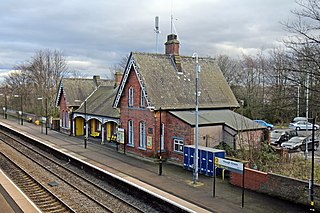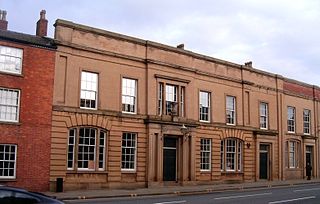
The Liverpool and Manchester Railway (L&MR) was the first inter-city railway in the world. It opened on 15 September 1830 between the Lancashire towns of Liverpool and Manchester in England. It was also the first railway to rely exclusively on locomotives driven by steam power, with no horse-drawn traffic permitted at any time; the first to be entirely double track throughout its length; the first to have a true signalling system; the first to be fully timetabled; and the first to carry mail.

Warrington Central railway station is one of three main railway stations serving the town of Warrington in Cheshire, England. It is located on the southern route of the Liverpool to Manchester Lines, being situated approximately halfway between the two cities.

Sankey railway station, also known as Sankey for Penketh, is a railway station in the west of Warrington, Cheshire, England, serving the Great Sankey, Penketh and Whittle Hall areas of the town. The station, and all trains serving it, are operated by Northern Trains. It is designated by English Heritage as a Grade II listed building.

Widnes railway station is a railway station serving the town of Widnes, Halton, England. It is recorded in the National Heritage List for England as a designated Grade II listed building. The station is operated by Northern Trains.

Hough Green railway station is a railway station to the west of Widnes in Halton, Cheshire, England. It is recorded in the National Heritage List for England as a designated Grade listed building. The station is on the Liverpool–Warrington–Manchester line 10 miles 42 chains (16.9 km) east of Liverpool Lime Street and all trains serving it are operated by Northern Trains.

Liverpool Road is a former railway station on the Liverpool and Manchester Railway in Manchester, England that opened on 15 September 1830. The station was the Manchester terminus of the world's first inter-city passenger railway in which all services were hauled by timetabled steam locomotives. It is the world's oldest surviving terminal railway station. With tracks running at a second floor level behind the building, it could also be considered one of the world's first elevated railway stations.

Weaste is a inner-city suburb of Salford, Greater Manchester, England. In 2014, Weaste and Seedley ward had a population of 12,616.

Wood Green railway station was a railway station that opened on the Grand Junction Railway in 1837. It served the Wood Green area of Wednesbury and Walsall. It closed in 1941. It was located near to where junction 9 of the M6 motorway has been located since the late 1960s.
Oldham Clegg Street railway station was the Oldham, Ashton-under-Lyne and Guide Bridge Junction Railway station that served the town of Oldham in northwest England, it had three associated goods stations.
For other stations named Ashton, see Ashton railway station (disambiguation)
Manchester Oldham Road station opened in 1839 as the terminus station of the Manchester and Leeds Railway (M&LR) in Collyhurst, Manchester. When the M&LR opened Manchester Victoria in 1844 as its new Manchester passenger station Oldham Road was converted to a goods station which it remained until its closure in 1968.
Atherton Bag Lane railway station served an area of Atherton, Greater Manchester in what was then Lancashire, England. It was located on the Bolton and Leigh Railway line which ran from Bolton Great Moor Street to Leigh Station and the Leeds and Liverpool Canal and later to Kenyon Junction.

Seedley railway station is a disused station located in the Seedley area of Salford, on the former Liverpool and Manchester Railway.
Leigh was a railway station in Bedford, Leigh, Greater Manchester, England, United Kingdom on the London and North Western Railway. Leigh was in the historic county of Lancashire. Its station opened as Bedford Leigh in 1864, was renamed Leigh & Bedford in 1876 and Leigh in 1914. The station closed in 1969.
Westleigh or West Leigh was a station in Leigh, Greater Manchester, England on the Bolton and Leigh Railway line. Westleigh was situated within the historic county of Lancashire. Its station opened in 1831 and closed in 1954.
Parkside railway station was an original station on the Liverpool and Manchester Railway. It then became the interchange station between lines when the Wigan Branch Railway opened in 1832, moving to the physical junction of the two lines in 1838. The station continued as an interchange until being by-passed in 1847 when a west curve was opened to facilitate north–south links that did not go through the station. Traffic declined further after the Winwick cut-off opened in 1864 leading to closure in 1878.
Golborne South railway station was one of two stations serving the town of Golborne, to the south of Wigan.

Lowton railway station served the village named Town of Lowton to the east of Newton-le-Willows and south of Golborne.

Preston Brook railway station was a station on the Grand Junction Railway serving the villages of Preston Brook and Preston on the Hill in what was then Cheshire, England. It opened on 4 July 1837 when the line opened.
Wavertree Lane was one of the original stopping-places on the Liverpool & Manchester Railway which opened in 1830. Stopping-places were commonly located at supervised level crossings where gatekeepers were available to signal trains to stop close to the point at which the line crossed the road, in this case Wavertree Lane. The stopping-places were generally primitive in nature without platform or shelter for passengers. Wavertree Lane appeared in the first official list of stopping-places issued in February 1831. The list was probably issued to reduce the number of informal intermediate stops requested by passengers. In the early days only second class trains made such request stops although mixed class trains were introduced subsequently.











